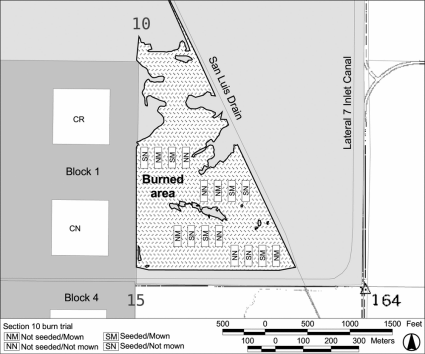THE BURN AND MOWING TRIAL

Figure 1. Experimental design of the Section 10 Burn and Mowing Trial; Tranquillity Land Retirement
Demonstration Site. Code to treatments: NN, Control (i.e., neither seeded nor mown); NM, Mown but not seeded;
SN, Seeded but not mown; SM, Seeded and Mown.
Overview
Section 10 on the Tranquillity site is an area dominated by Bromus madritensis (red brome), with a characteristically heavy layer of thatch. Prescribed fire is a common management tool that also possesses utility in restoration strategies, and has been demonstrated to be effective in grass-dominated habitats (cf. Pollak and Kan 1998; Wilson and Stubbendieck 2000).
The Section 10 Burn and Mowing Trial was developed in order to take advantage an accidental fire that burned a large portion of Section 10 in June 2002. The timing of the accidental burn was not optimal in terms of controlling the winter-germinating grasses. Nevertheless, it was a good opportunity to evaluate the restoration potential of some seemingly fire-adapted native species. Mowing, another common management tool was incorporated in the trial as a second treatment factor.
Shortly after the fire, the burned area was mapped using a global positioning system receiver in June. Four "blocks" were designated within the burned area; these blocks were delineated in such a manner as to "standardize" the burn intensity of the areas selected for the study plots. Plots were ca. 0.2 ha (0.5 ac) in size; a complete randomized block design was applied, with treatments replicated four times. A mixture containing seed of seven native species (Table 1) was imprinted. In order to subject the control plots to the same level of disturbance as the treated plots, an empty imprinter was run over the control plots.
Data were collected from 12 quadrats (35 x 70 cm) per plot. Imprinting occurred on 22 November, 2002. The "mowing" plots were mown a single time (March 28, 2003). Although it was anticipated that the plots might need to be mowed multiple times, weed growth under that year's extremely dry conditions was not sufficient to warrant additional mowing. Vegetation monitoring was conducted on 5 May, 2003.
Table 1. Species imprinted in the Section 10 Burn and Mowing Trial, including family, common name, life-form, and seeding rate. Seeding rates are expressed as pure live seeds per square foot (PLS/ft2).
| Taxon | Family | Common Name | Life-form | Seeding Rate |
|---|---|---|---|---|
| Allenrolfea occidentalis | Chenopodiaceae | iodinebush | shrub | 7.01 |
| Atriplex spinifera | Chenopodiaceae | spinescale saltbush | shrub | 4.48 |
| Frankenia salina | Frankeniaceae | alkali heath | perennial herb | 10.06 |
| Hemizonia pungens | Asteraceae | common spikeweed | annual herb | 9.83 |
| Lasthenia californica | Asteraceae | California goldfields | annual herb | 15.62 |
| Sesuvium verrucosum | Aizoaceae | western sea-purslane | perennial herb | 5.35 |
| Sporobolus airoides | Poaceae | alkali sacaton | perennial herb | 8.03 |
References
Pollak, O. and T. Kan. 1998. The use of prescribed fire to control invasive exotic weeds at Jepson Prairie Preserve. pp. 241-249. In: Ecology, Conservation, and Management of Vernal Pool Ecosystems - Proceedings from a 1996 Conference. California Native Plant Society, Sacramento, CA. Witham, C. W., Bauder, E. T., Belk, D., Ferren, W. R. J. and Ornduff, R. (eds.). Sacramento, CA.
Wilson, G. D. and J. Stubbendieck. 2000. A provisional model for smooth brome management in degraded tallgrass prairie. Ecol. Rest. 18: 34-38.
Page created: March 1, 2005; Last updated: March 13, 2006